Welcome to our guide on Singer sewing machine manuals for old machines. These manuals provide essential insights for restoring, operating, and maintaining vintage Singer sewing machines effectively. Whether you’re a collector or a sewer, these resources are invaluable for understanding your machine’s history and functionality. With many original manuals now scarce, replica versions offer a practical solution for enthusiasts. Discover how to keep your vintage Singer in top condition with these comprehensive guides.
Overview of Singer Sewing Machines
Singer sewing machines have been a cornerstone of sewing technology since the 1800s, renowned for their durability and innovative designs. These machines, often made with robust metal and cast iron frames, have stood the test of time, making them favorites among collectors and sewers alike. Vintage Singer models, such as the 66 and 99, are celebrated for their reliability and versatility, capable of handling various fabrics and stitches. Their enduring popularity stems from their craftsmanship and performance, ensuring they remain functional and cherished even after decades of use. Singer sewing machines are not only functional tools but also pieces of history, reflecting the evolution of sewing technology.
Importance of Manuals for Vintage Sewing Machines
Manuals for vintage Singer sewing machines are indispensable for understanding and maintaining these timeless devices. They provide detailed instructions for operation, maintenance, and troubleshooting, ensuring optimal performance. Without a manual, users may struggle with threading, tension adjustments, and repair. These guides also offer insights into the machine’s history and unique features. For collectors, manuals add value, as they often include original specifications and care tips. Additionally, manuals help users identify compatible parts and accessories, which is crucial for preserving the machine’s functionality. Their availability bridges the gap between past and present, making vintage Singer machines accessible to new generations of sewers and enthusiasts.

Understanding Singer Sewing Machine Models
Singer produced diverse sewing machine models with unique features. Understanding these models is crucial for their proper operation and maintenance, guided by their manuals for vintage machines.
Identifying Vintage Singer Sewing Machine Models
Identifying vintage Singer sewing machine models requires examining the machine’s serial number, model number, and physical features. The serial number, often found on a metal plate, helps determine the manufacturing date. Model numbers, typically located near the bobbin area or on the base, indicate specific designs. Vintage models may feature distinctive decals, ornate designs, or unique stitch patterns. Consulting original manuals or Singer’s historical records can aid in accurate identification. Rare or limited-edition models, such as the Singer 301 or Featherweight, are highly sought after by collectors. Proper identification is essential for restoration, maintenance, and understanding the machine’s heritage.
Popular Old Singer Sewing Machine Models
Among vintage Singer sewing machines, models like the Singer 301, Featherweight 221, and 66 are highly prized by collectors and sewers. The Featherweight 221, known for its portability and durability, is a favorite for quilting. The Singer 301, with its versatility and range of stitches, is ideal for heavy-duty projects. The Singer 66, a classic from the early 20th century, is celebrated for its simplicity and reliability. These models, often sought after for their robust construction and timeless design, hold significant historical and practical value. Their enduring popularity underscores the legacy of Singer’s craftsmanship and innovation in sewing technology.
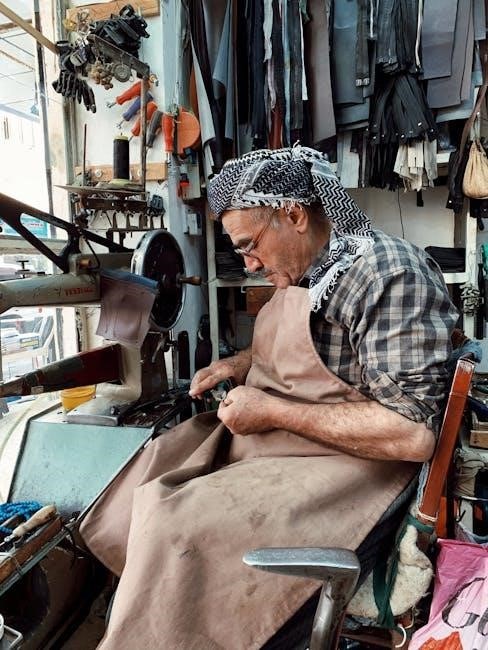
Locating Singer Sewing Machine Manuals
Locating Singer sewing machine manuals can be challenging, but online archives and collector communities often provide access to original or reproduction versions for vintage models.
Where to Find Original Singer Sewing Machine Manuals
Original Singer sewing machine manuals can be found through various avenues. Online marketplaces like eBay and Etsy often have vintage manuals for sale. Specialized sewing communities and forums may also share or sell original documents. Antique shops and sewing machine repair stores sometimes carry vintage manuals for specific models. Additionally, local auctions or estate sales might have these rare resources. Enthusiasts often digitize and share manuals online, making them accessible for download. Always verify the manual’s authenticity and compatibility with your machine’s model number before purchasing or downloading. These resources are invaluable for maintaining and operating vintage Singer sewing machines effectively.
Downloading Singer Sewing Machine Manuals Online
Downloading Singer sewing machine manuals online is a convenient and accessible option for vintage enthusiasts. Many websites offer free or paid downloads of original and replica manuals. Platforms like eBay, Etsy, and specialized sewing forums often host digital versions. Ensure the manual matches your machine’s exact model number for accuracy. Some communities share scanned copies of rare manuals, while others provide PDF versions for easy access. This method saves time and effort compared to physical searches. Additionally, online libraries and archive sites may have vintage manuals available for download. Always verify the source’s reliability to ensure the manual’s authenticity and quality.
Reproduction and Replica Manuals for Old Machines
Reproduction and replica manuals are invaluable for owners of vintage Singer sewing machines, especially when original manuals are scarce. These replicas are meticulously recreated from original sources, ensuring accuracy and usability. They often include detailed diagrams, parts lists, and operating instructions, making them indistinguishable from the originals. Many enthusiasts and collectors rely on these replicas to maintain and restore their machines. Replica manuals are widely available through online marketplaces like Etsy and eBay, as well as specialty sewing communities. They provide a cost-effective solution for those seeking to preserve the functionality and heritage of their vintage Singer sewing machines, ensuring their longevity for future generations.
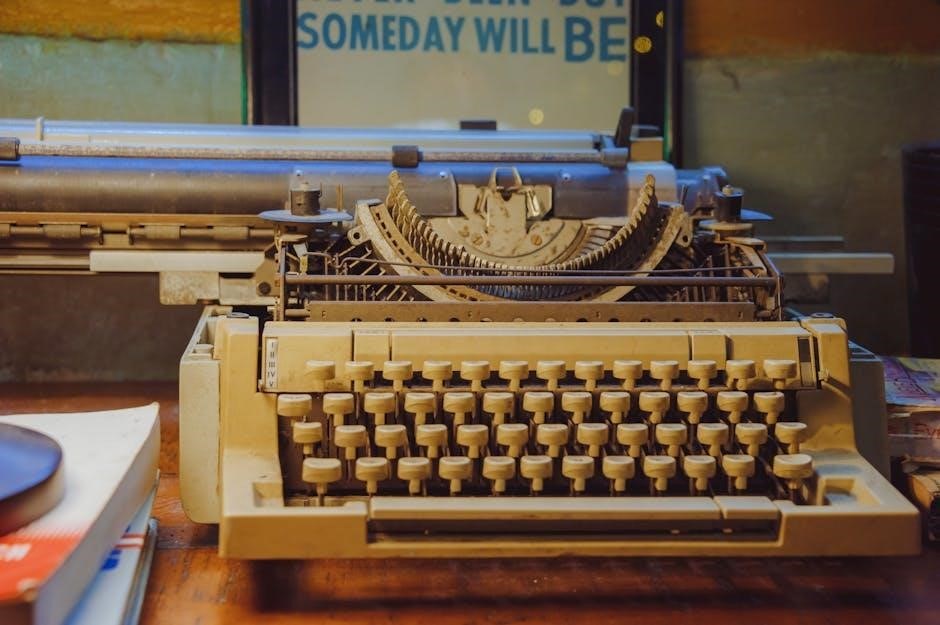
Key Features of Singer Sewing Machine Manuals
Singer sewing machine manuals feature detailed parts lists, diagrams, maintenance tips, troubleshooting guides, and operating instructions, ensuring comprehensive support for vintage machine owners and enthusiasts alike;
Parts and Accessories Information
Singer sewing machine manuals provide detailed parts lists, ensuring users can identify and source components specific to their model. Diagrams and illustrations help locate internal mechanisms, while compatibility charts guide accessory selection. These resources are crucial for maintaining and repairing vintage machines, offering insights into original specifications. Manuals often include tips for sourcing rare or discontinued parts, enabling enthusiasts to restore their machines authentically. Additionally, they highlight essential accessories like presser feet, bobbins, and needles, tailored for optimal performance. This information is invaluable for both collectors and active users, ensuring their vintage Singer machines remain functional and in pristine condition for years to come.
Operating Instructions for Vintage Models
Singer sewing machine manuals offer step-by-step guides for operating vintage models, ensuring users understand their machine’s unique features. From threading techniques to stitch selection, these manuals provide clear instructions tailored to specific models. They often include diagrams to illustrate proper setup and usage, making it easier for users to master basic and decorative stitches. Additionally, manuals address fabric compatibility, tension adjustments, and troubleshooting common issues. By following these guidelines, enthusiasts can optimize their vintage Singer’s performance while preserving its functionality. The instructions are designed to help users unlock their machine’s full potential, whether for everyday sewing or intricate projects.
Troubleshooting Guides for Old Machines
Troubleshooting guides in Singer sewing machine manuals help users diagnose and resolve common issues in vintage models. These guides cover problems like uneven stitching, thread breakage, and machine jamming, offering practical solutions. They often include detailed diagrams and step-by-step instructions to address mechanical and electrical faults. Tips on adjusting tension, cleaning, and lubricating parts are also provided to maintain smooth operation. Additionally, these guides advise on identifying worn or damaged components that may need replacement. By following these troubleshooting steps, enthusiasts can extend the lifespan of their vintage Singer machines and ensure consistent performance. These resources are invaluable for preserving functionality and usability.
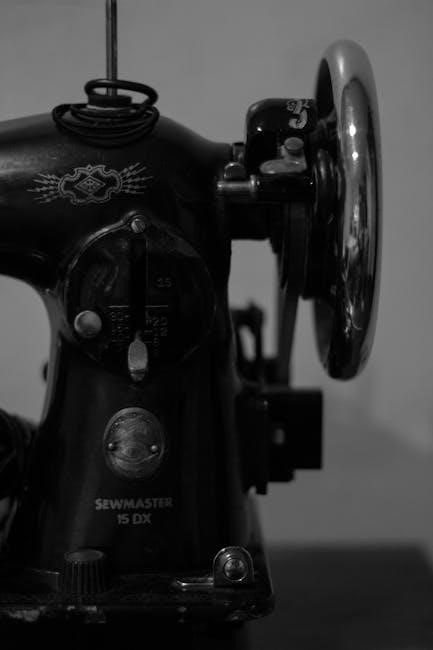
Maintenance and Care Instructions
Proper maintenance involves regular cleaning with a soft cloth, oiling with sewing machine oil, and avoiding harsh chemicals. Use appropriate materials to preserve functionality and longevity.
Cleaning and Oiling Vintage Singer Machines
Cleaning and oiling are crucial for maintaining vintage Singer machines. Use a soft cloth to wipe away dust and debris, paying attention to intricate parts. Apply sewing machine oil to moving components, ensuring smooth operation. Avoid harsh chemicals, as they can damage finishes or harm internal mechanisms. Regular maintenance prevents rust and keeps the machine functional. For thorough cleaning, gently brush or use compressed air to remove dirt from hard-to-reach areas. Always follow the manual’s guidelines for specific oiling points and cleaning techniques. Proper care extends the life of your vintage Singer, preserving its performance and heritage for years to come.
Regular Maintenance Tips for Old Sewing Machines
Regular maintenance is essential for preserving the functionality of vintage Singer sewing machines. Routinely inspect and clean the machine to remove dust and debris, which can hinder performance. Lubricate moving parts with sewing machine oil, focusing on areas like the bobbin case and handwheel. Check for worn or loose belts and replace them as needed. Store the machine in a dry, cool place to prevent rust. Avoid using harsh chemicals, as they can damage the finish or harm internal components. Perform these tasks every few months or before extended use to ensure smooth operation and extend the machine’s lifespan.
Replacing Parts on Antique Singer Machines
Replacing parts on antique Singer sewing machines requires careful attention to ensure compatibility and functionality. Identify worn or damaged components such as belts, bobbins, or gears and source authentic or reproduction parts. Clean the machine thoroughly before installation to prevent contamination. Use sewing machine oil to lubricate moving parts post-replacement. Avoid substituting modern components unless they are specifically designed for vintage models. Consult the manual for guidance on disassembly and reassembly. Proper replacement not only restores performance but also preserves the machine’s historical integrity and value, making it a worthwhile investment for collectors and enthusiasts alike.
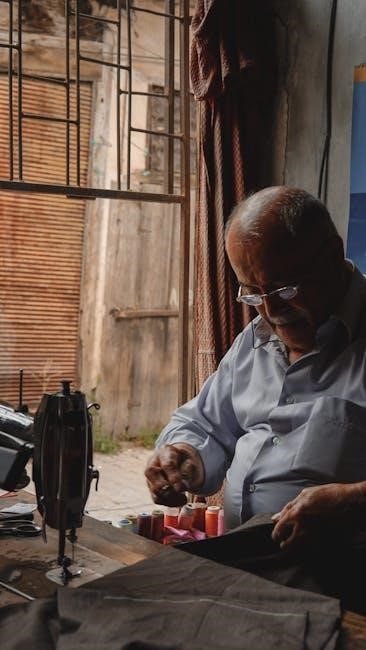
Troubleshooting Common Issues
Identify and resolve common issues like uneven stitching or jammed parts using Singer manuals. Regular cleaning and oiling can prevent many problems. Consult guides for step-by-step solutions.
Fixing Tension Problems in Old Machines
Tension issues in vintage Singer sewing machines can cause uneven stitching or fabric pulling. Consult the manual for model-specific adjustments. Check the upper thread tension dial and bobbin case for proper alignment. Re-threading the machine with the presser foot up often resolves imbalance. If loops appear on the underside, tighten the bobbin tension. For persistent problems, clean and oil the tension discs. Avoid over-tightening, as this can damage components. Regular maintenance, like dusting and lubricating, prevents tension-related issues. Always refer to your Singer manual for precise instructions tailored to your machine’s design and age.
Repairing Broken or Jammed Parts
Repairing broken or jammed parts in vintage Singer sewing machines often requires careful disassembly and attention to detail. Consult the manual for guidance on identifying and accessing faulty components. Common issues include jammed gears, broken tension springs, or stuck bobbin cases. Use screwdrivers and tools suitable for your machine’s age to avoid damaging screws or finishes. Clean and oil moving parts to resolve jams caused by dirt or rust. For broken parts, seek Singer-compatible replacements or fabricate them if unavailable. Always follow manual instructions for reassembly and test the machine gradually to ensure proper function. Patience and precision are key to restoring your machine to working order.
Addressing Motor and Gear Issues
Motor and gear issues in vintage Singer sewing machines can arise due to wear, dust, or misalignment. Start by consulting the manual for troubleshooting steps. Clean gears thoroughly with a soft brush and mild solvent, then lubricate with sewing machine oil. If gears are damaged, replace them with compatible parts. For motor problems, check power cords and internal wiring. Ensure the machine is unplugged before performing repairs. Lubricate moving parts regularly to prevent friction. If issues persist, consider consulting a professional. Proper care and maintenance can extend the life of your machine and ensure smooth operation for years to come.

Restoring Old Singer Sewing Machines
Restoring vintage Singer sewing machines involves cleaning, lubricating, and replacing worn parts. Use original manuals for precise guidance to preserve functionality and historical value effectively.
Step-by-Step Restoration Process
Restoring old Singer sewing machines requires a meticulous approach. Begin by evaluating the machine’s condition, noting any damage or missing parts. Next, clean thoroughly, removing dirt and grime using gentle brushes and soft cloths. Lubricate moving parts with sewing machine oil to ensure smooth operation. Replace worn or broken components, such as needles, belts, or tension discs, using compatible parts. Carefully polish the exterior to restore its original finish. Finally, test the machine by sewing a sample fabric to ensure proper function. Refer to manuals for specific instructions to maintain authenticity and performance during the restoration process.
Tools and Materials Needed for Restoration
Restoring old Singer sewing machines requires specific tools and materials. Essential tools include screwdrivers, brushes for cleaning, and a sewing machine oil can. Soft cloths and gentle cleaning solutions help remove grime without damaging finishes. Replacement parts, like needles, belts, and bobbins, should be sourced from compatible suppliers. Polishing compounds and wax are used to restore the machine’s exterior shine. A workbench and good lighting are also crucial for detailed work. Always refer to the manual for part numbers and compatibility. Sourcing genuine or replica parts ensures authenticity and proper functionality during the restoration process.
Refinishing and Polishing Vintage Machines
Refinishing and polishing vintage Singer sewing machines require careful attention to detail. Start by disassembling removable parts and gently cleaning surfaces with a soft cloth and mild cleaning solution. For metal components, use a specialized polish to restore their original shine. Avoid harsh chemicals that might damage finishes. Once clean, apply a thin layer of wax or clear coat to protect the surface. Buff the machine thoroughly to achieve a polished look. For intricate designs or engravings, use a small, soft-bristled brush to reach detailed areas. Regular polishing helps maintain the machine’s aesthetic appeal and protects it from further deterioration over time.
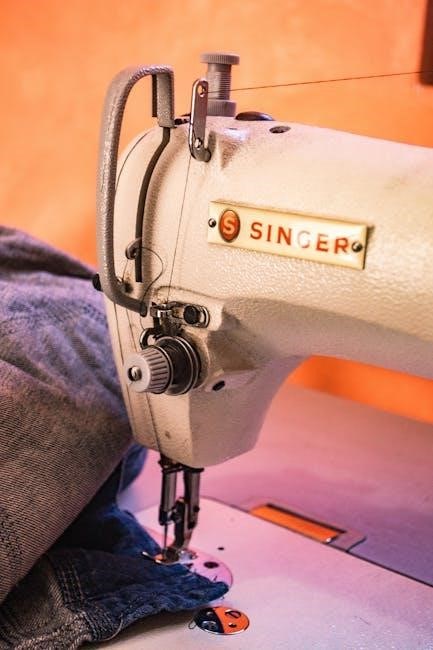
Using Vintage Singer Sewing Machines
Discover the joy of sewing with vintage Singer machines. Learn threading, setup, and fabric selection. Master basic stitches and enjoy creating with timeless craftsmanship.
Threading and Setting Up the Machine
Proper threading and setup are crucial for optimal performance of vintage Singer sewing machines. Always refer to the manual for specific guidance, as processes vary by model. Begin by locating the spool pins and tension discs, ensuring the thread is correctly routed through each part. Use the handwheel to raise the take-up lever before threading to prevent tangles. Once threaded, test the machine on scrap fabric to ensure even stitches. Regularly clean and oil the machine to maintain smooth operation. Proper setup ensures consistent stitching and extends the machine’s lifespan, making it a reliable tool for sewing projects.
Choosing the Right Fabric for Vintage Machines
Selecting the right fabric for vintage Singer sewing machines is essential for achieving optimal results. These machines excel with medium-weight fabrics like cotton, linen, and lightweight wool. Heavier fabrics, such as denim or thick upholstery material, may require adjustments to tension and stitch length. Delicate fabrics like silk or chiffon can be challenging, often needing a specialized touch. Always test fabric scraps beforehand to ensure compatibility and stitch quality. Using appropriate fabrics ensures smooth operation and prevents damage to the machine. Vintage machines are versatile but may struggle with overly thick or stretchy materials, so choose wisely for best performance.
Mastering Basic Stitches on Old Machines
Mastering basic stitches on vintage Singer sewing machines is essential for achieving professional results. These machines often feature a range of built-in stitches, including the straight stitch, backstitch, and running stitch. Practice on scrap fabric to ensure even tension and consistent stitch length. The straight stitch is ideal for seaming and repairing, while the backstitch is perfect for reinforcing seams. For gathering fabric, the running stitch is a timeless choice. Vintage machines may require manual adjustment of stitch length and width, so refer to your manual for guidance. With practice, these foundational stitches will become second nature, allowing you to tackle various sewing projects with confidence.
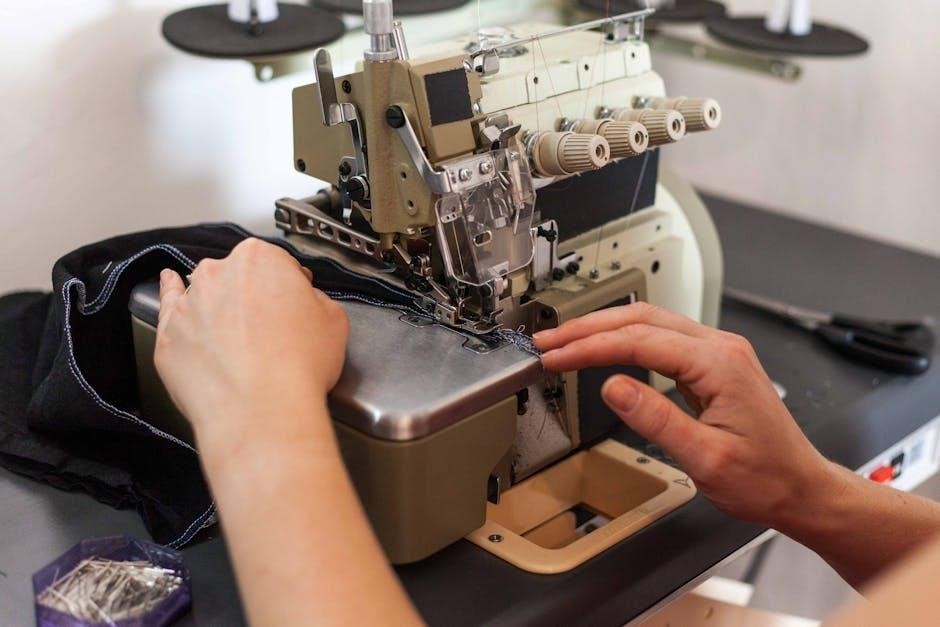
Singer Sewing Machine Collectibility
Singer sewing machines are highly sought after by collectors due to their historical significance, durable craftsmanship, and nostalgic appeal. Rare models and well-preserved machines often hold high value.
The History and Value of Antique Singer Machines
Singer sewing machines have a rich history dating back to the 1800s, with early models like the Turtle Back and Red Eye becoming highly collectible. Their value is determined by rarity, condition, and historical significance. Antique Singer machines are prized for their durable construction and craftsmanship, often outlasting modern counterparts. While some models fetch high prices at auctions, others are cherished for their sentimental and historical worth. Original manuals, like those for the Singer Merritt 6620C, add to a machine’s value. Collectors seek these vintage machines for their aesthetic appeal and functional longevity, making them treasured possessions for sewing enthusiasts and historians alike.
Factors Affecting the Value of Old Sewing Machines
The value of old sewing machines is influenced by several factors, including rarity, condition, and historical significance. Models with unique features or limited production runs often command higher prices. The presence of original accessories, such as Singer sewing machine manuals, can significantly enhance value; Machines in working condition are generally more desirable than non-functional ones. Additionally, the popularity of certain models among collectors and their aesthetic appeal play a role. The availability of replacement parts and the machine’s historical background also impact its worth. As seen with models like the Singer Merritt 6620C, even older machines can retain value due to their durability and craftsmanship.
Popular Singer Models Among Collectors
Certain Singer sewing machine models are highly sought after by collectors due to their historical significance, unique features, and durability. The Singer 201, 301, and Featherweight models are particularly prized for their lightweight yet robust construction and versatile stitching capabilities. Additionally, the Singer Red Eye and 99K models are favorites among enthusiasts for their timeless design and reliability. These machines often come with original Singer sewing machine manuals, which further enhance their value. Collectors also appreciate models with ornate decorations or special editions, as they reflect the craftsmanship of earlier eras. The popularity of these models underscores the enduring appeal of vintage Singer sewing machines.
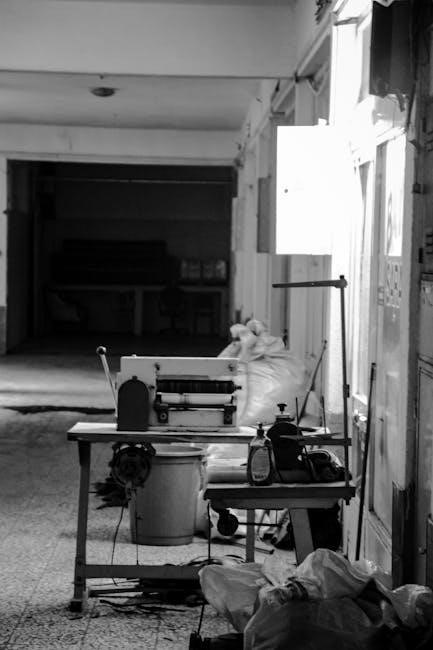
Resources for Vintage Sewing Machine Enthusiasts
Enthusiasts can explore various resources, including online communities, specialized repair shops, and detailed guidebooks, to support their passion for vintage sewing machines and manuals.
Online Communities and Forums
Online communities and forums are invaluable for enthusiasts seeking advice on vintage Singer sewing machines. Platforms like Singer Sewing Machine Collectors or Facebook groups dedicated to vintage sewing machines offer spaces to share knowledge. Members often discuss restoration tips, troubleshooting, and maintenance. These forums are great for finding rare manual scans or connecting with experts. Many enthusiasts recommend specific sites for downloading manuals or guides. Participants frequently exchange experiences on cleaning, threading, and operating old machines. These communities foster a sense of camaraderie and provide access to resources that might otherwise be hard to find. They are a lifeline for preserving these vintage gems.
Specialized Repair Shops for Old Machines
Specialized repair shops for old sewing machines are a vital resource for enthusiasts. These shops often cater specifically to vintage models, offering expert services for cleaning, oiling, and replacing parts. Technicians in these shops typically have extensive experience with Singer machines and can address issues that manuals may not cover. Many shops also provide access to rare or hard-to-find parts, ensuring your machine runs smoothly. While some repairs can be done at home, complex problems often require professional attention. Finding a reputable shop can be done through online forums or local sewing groups, making it easier to maintain your vintage Singer’s optimal condition.
Books and Guides on Antique Sewing Machines
Books and guides on antique sewing machines are invaluable resources for enthusiasts and collectors. These publications often delve into the history, restoration, and maintenance of vintage Singer machines. Many guides provide detailed instructions for troubleshooting, cleaning, and oiling, while others focus on the historical significance and collectibility of specific models. For those interested in DIY repairs, these books can serve as comprehensive manuals. Additionally, they frequently include tips for identifying rare parts and understanding the mechanical intricacies of old machines. Whether you’re a seasoned collector or a novice sewer, these books offer insights that go beyond basic manuals, helping you fully appreciate and preserve your vintage Singer sewing machine;
Singer sewing machine manuals are vital for restoring, operating, and maintaining vintage machines. They provide essential guidance, ensuring these timeless devices continue to function and inspire future generations.
Final Thoughts on Singer Sewing Machine Manuals
Singer sewing machine manuals are invaluable resources for enthusiasts, offering detailed guidance for vintage machines. Whether you’re restoring, maintaining, or operating an old Singer, these manuals provide essential insights. Original manuals are rare, but replicas and online versions help bridge the gap. They not only preserve the legacy of these timeless machines but also empower users to keep them functional. For collectors and sewers alike, these manuals are a gateway to understanding and appreciating the craftsmanship of Singer’s historic models. Embrace the journey of working with vintage machines, and let these manuals be your trusted companions in preserving sewing history.
Encouragement to Explore and Preserve Vintage Machines
Exploring and preserving vintage Singer sewing machines is a rewarding journey that connects us to the past while fostering creativity. These machines, with their durable construction and timeless design, offer a unique sewing experience. By restoring and maintaining them, you not only keep their legacy alive but also gain a deeper appreciation for craftsmanship. Whether you’re a collector, a sewer, or simply a history enthusiast, vintage machines invite you to embrace their charm. Join a community of like-minded individuals who value these treasures, and use the available manuals and resources to ensure they continue to inspire future generations.